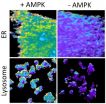The connection between mouth bacteria and inflammation in heart disease
2015-04-16
(Press-News.org) Oral infections are the most common diseases of mankind and are also a key risk factor for heart disease, which is the leading cause of death worldwide. In a review article published in Trends in Endocrinology and Metabolism on April 16, researchers summarize the latest clinical evidence supporting a link between oral infections, which are caused by the bacteria in our mouth, and heart disease, and they emphasize the important role of inflammation in both of these conditions.
"Given the high prevalence of oral infections, any risk they contribute to future cardiovascular disease is important to public health," says senior author Thomas Van Dyke of the Forsyth Institute. "Unravelling the role of the oral microbiome and inflammation in cardiovascular disease will likely lead to new preventive and treatment approaches." The (oral) microbiome refers to the totality of microorganisms in a body part-in this case the mouth--that we all co-exist with.
The most common oral infections are cavities and periodontal diseases such as gingivitis and periodontitis, which are chronic inflammatory diseases that slowly and steadily destroy the supporting structures of multiple teeth. Significant epidemiological evidence supports an association between oral infections, particularly periodontitis, and stroke, especially among men and younger individuals.
Inflammation plays a major role both in oral infections such as periodontitis and in cardiovascular disease. However, over-the-counter nonsteroidal anti-inflammatory drugs such as ibuprofen can produce significant cardiovascular side effects, which means it is crucial that we consider alternative therapies. A high dose of a commonly prescribed cholesterol-lowering medication, atorvastatin, which boosts blood levels of anti-inflammatory molecules called lipoxins and resolvins, prevents both periodontal and cardiovascular inflammation and reverses existing disease in humans. This is exciting and promising because lipoxins and resolvins also have the advantage of naturally controlling inflammation without suppressing the immune system.
"New discoveries of natural pathways that resolve inflammation have offered many opportunities for revealing insights into disease pathogenesis and for developing new pharmacologic targets for the treatment of both oral infections and cardiovascular disease," Van Dyke says.
In future studies, it will be important to compare the effectiveness of these inflammation-reducing molecules, which we produce naturally, and other interventions that could potentially prevent or reverse periodontitis and cardiovascular disease. Another open question is whether there is a reverse relationship between these conditions: what if the onset of cardiovascular disease influences the presence or progression of periodontal disease? Or what are some of the common genetic mechanisms underlying periodontitis and cardiovascular disease?
In the meantime, Van Dyke recommends that people take better care of their teeth to potentially lower their risk of cardiovascular disease and other health problems. "The majority of diseases and conditions of aging, including obesity and type 2 diabetes, have a major inflammatory component that can be made worse by the presence of periodontitis," he says. "Periodontitis is not just a dental disease, and it should not be ignored, as it is a modifiable risk factor."
INFORMATION:
Trends in Endocrinology & Metabolism, Kholy et al.:"Oral infections and cardiovascular disease" http://dx.doi.org/10.1016/j.tem.2015.03.001
Trends in Endocrinology & Metabolism (TEM), published by Cell Press, is a monthly review journal that publishes polished, concise, highly read and cited articles of topics at the cutting edge of metabolic diseases covering both clinical and research aspects of the field; from state-of-the-art treatments of endocrine diseases to new developments in molecular biology. For more information, please visit http://www.cell.com/trends/endocrinology-metabolism. To receive media alerts for TEM or other Cell Press journals, please contact press@cell.com.
ELSE PRESS RELEASES FROM THIS DATE:
2015-04-16
By analyzing the activity of "GPS" neurons in mice, researchers at the Stanford University School of Medicine have discovered that the mental maps created by these cells accumulate errors, which are corrected when the animal encounters a wall.
The findings support the theory that these cells, called grid cells, use an animal's perceived speed and direction to help it navigate familiar places.
Thus, as you stumble through your pitch-black kitchen in the middle of the night for a glass of water, your body knows how many steps to take and when to turn to get to the sink. ...
2015-04-16
Men give more money through fundraising websites after seeing that other men have donated large amounts and when the fundraiser is an attractive woman, according to new UCL and University of Bristol research.
The scientists say this response by men is unlikely to be conscious and could have an evolutionary function as theories predict that generous actions can honestly signal hidden qualities, such as wealth or desirable personality attributes, to potential partners.
Co-author Dr Nichola Raihani from UCL (Life Sciences), said: "We looked at why people behave generously ...
2015-04-16
A nerve neglected in today's era of molecular and genetic analysis has yielded a surprising secret. A handful of neurons control breathing in a fine-tuned but powerful way, scientists have discovered in mice. Among these sensory neurons, two types are dedicated to two specific respiratory functions.
The findings, published in Cell, suggest new ways of considering clinical conditions related to the vagus nerve.
The team, led by Stephen Liberles, Harvard Medical School associate professor of cell biology, has effectively deconstructed the vagus nerve, a key connection ...
2015-04-16
The enzyme AMPK initiates a dizzying array of cellular activities, from breaking down worn-out cellular parts to turning on energy production. How does a single protein, activated by a single switch, fulfill so many different tasks without getting them mixed up? To get at such a complex question, cell biologists at Johns Hopkins designed several molecular tools that allowed them to watch, measure and manipulate the activity of the enzyme AMPK in individual compartments within the cell. The new tools have confirmed that at least some of AMPK's ability to multitask comes ...
2015-04-16
Angiogenesis inhibitors--a widely used class of cancer drugs designed to shrink tumors by preventing them from forming new blood vessels--often work in the short term, but usually become ineffective within months. Now, a team led by UC San Francisco scientists has discovered a possible reason, one that could lead to a way to address the problem and prevent cancer relapse.
Working with laboratory models of pancreatic and breast cancer, the scientists found that myeloid cells, which originate in bone marrow and are part of the body's first-line of defense--the so-called ...
2015-04-16
How does climate change affect the occurrence and distribution of species? This is a key question in the climate debate, and one that is hard to answer without information about natural variation in species abundance. Now researchers from Uppsala University can, for the first time, give us a detailed picture of natural variation through a major study published today in the leading scientific journal Current Biology.
The impact of climate change on species occurrence and distribution is a central issue in the climate debate, since human influence on the climate risks posing ...
2015-04-16
The nutrients excreted by fish in their "pee" may be critical to the health of coastal ecosystems. But knowing whether generalizations can be made about how to predict these nutrient levels in various ecosystems has vexed researchers - until now.
In a paper published in Proceedings of the National Academy of Sciences, North Carolina State University associate professor Craig Layman and colleagues show that ecologists can better predict the rates of how these chemical nutrients are transferred by fish if they know the various fish species living in an ecosystem, along ...
2015-04-16
An international team of scientists, led by researchers at University of California, San Diego School of Medicine, have found genetic overlap between Alzheimer's disease (AD) and two significant cardiovascular disease risk factors: high levels of inflammatory C-reactive protein (CRP) and plasma lipids or fats. The findings, based upon genome-wide association studies involving hundreds of thousands of individuals, suggest the two cardiovascular phenotypes play a role in AD risk - and perhaps offer a new avenue for potentially delaying disease progression.
The findings ...
2015-04-16
A potentially game-changing breakthrough in artificial photosynthesis has been achieved with the development of a system that can capture carbon dioxide emissions before they are vented into the atmosphere and then, powered by solar energy, convert that carbon dioxide into valuable chemical products, including biodegradable plastics, pharmaceutical drugs and even liquid fuels.
Scientists with the U.S. Department of Energy (DOE)'s Lawrence Berkeley National Laboratory (Berkeley Lab) and the University of California (UC) Berkeley have created a hybrid system of semiconducting ...
2015-04-16
CORVALLIS, Ore. - A national survey suggests that slightly more than half of the older adults in the United States are now taking a daily dose of aspirin, even though its use is not recommended by the Food and Drug Administration for most people who have not yet had a heart attack or stroke.
The analysis was published today in the American Journal of Preventive Medicine. It observed that aspirin use is continuing to surge, especially among adults who are using it for "primary prevention," meaning in order to prevent an initial cardiovascular event, and in some cases to ...
LAST 30 PRESS RELEASES:
[Press-News.org] The connection between mouth bacteria and inflammation in heart disease


